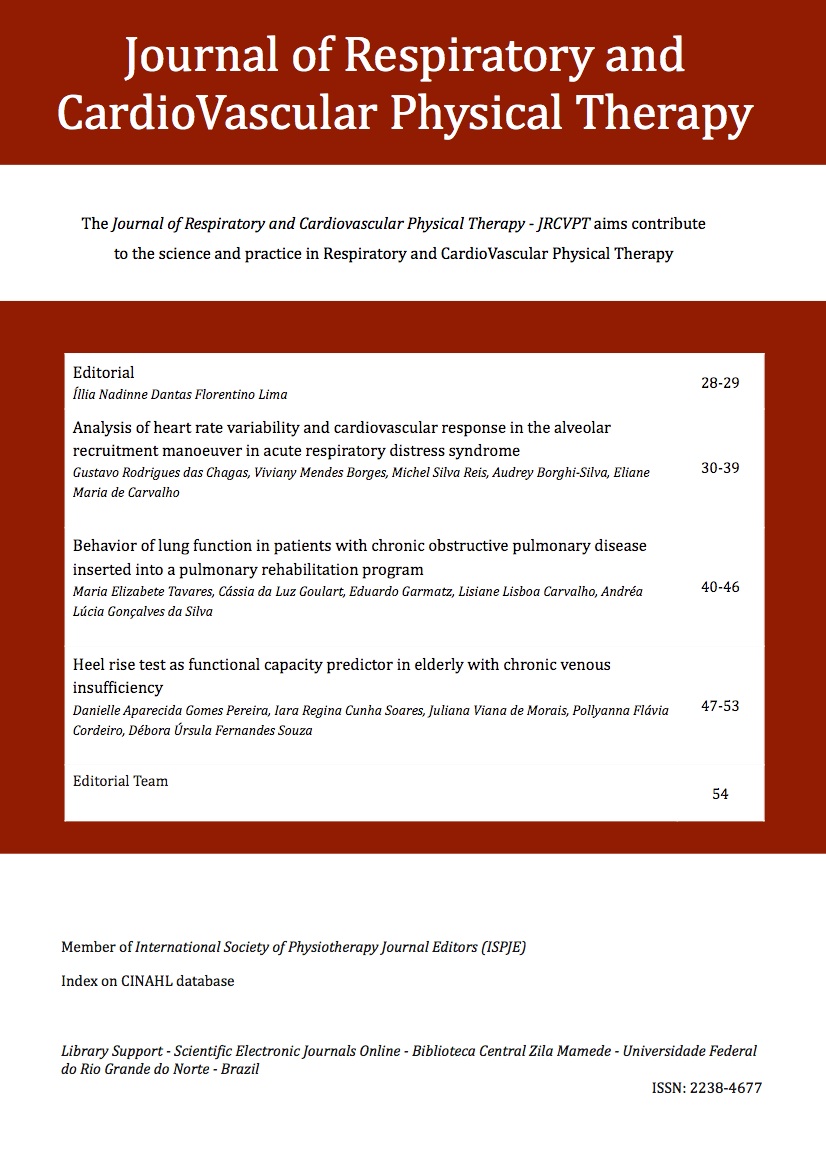Heel rise test as functional capacity predictor in elderly with chronic venous insufficiency
Keywords:
Venous Insufficiency, Health of the Elderly, Physical Therapy Speciality, Exercise Test.Abstract
Objectives: The aim of the study was to assess whether Heel Rise Test (HRT) is able to predict functional capacity in elderly patients who have Chronic Venous Insufficiency (CVI).
Methods: The sample consisted of individuals aged between 60 and 90 years diagnosed with CVI. The Incremental Shuttle Walk Test (ISWT) and HRT were done in the same day, in random order. The variables of the study: maximal distance, time and speed on ISWT; number of repetitions, time and repetition rate on HRT. The simple linear regression model was used to check how much HRT predicts the functional capacity in the elderly with CVD. The one-way ANOVA technique was used in order to compare the variables of the ISWT and HRT among the different age groups. The intra rater reliability of HRT was performed with intraclass correlation coefficient. The adopted significance level was p <0.05.
Results: Sixty-one individuals between 60-89 years (74.21 ± 8.10) with CVI performed all tests (51 females). The correlation between the number of plantar flexion and repetition rate of HRT in relation to distance, time and ISWT speed was statistically significant (p < 0.05). The time variable between HRT and ISWT did not show any significant correlation. A linear regression model that includes HRT repetition rate as independent variable explained 13% of maximum distance in ISWT (R²= 0.13; p<0.05). The comparison of same variables in different age groups showed significant difference only for the ISWT maximum distance.
Conclusions: The muscle performance is not the only factor that predicts functional capacity. Other factors are stronger determinants of functional capacity in older adults with mild severity of CVI.
Downloads
Downloads
Additional Files
Published
How to Cite
Issue
Section
License
Copyright Transfer Statement
The author(s) of the article, as specified here, hereby transfer(s) to the Revista de Fisioterapia Respirtória e CardioVascular (Journal of Respiratory and CardioVascular Physical Therapy) all copyright ownership rights, title and interests that the author(s) may have or may come to have in and to the article and any revision or version thereof, including, but not limited to, exclusive right to print, publish and sell the article anywhere in the world, in any language and in any media.
This agreement will be considered effective and valid if and when the article is accepted for publication.
If the article contains any copyright-protected material from a third party, the author(s) must obtain written permission to reproduce the said material in the article from the copyright holder and send it to the Revista de Fisioterapia Respirtória e CardioVascular (Journal of Respiratory and CardioVascular Physical Therapy).
The author(s) guarantee(s) the holding of proprietary rights to the article; not having granted or transferred any rights to the article to any other persons or entity; that the article is susceptible to the demand for rights by its author(s); not having infringed upon any author rights, trademark or patent; not having violated the right to privacy or publicity of any person or entity; that the article does not contain any defaming subject; that the factual statements made are true or are based on reasonably accurate research; and, finally, that, the author(s) has/have no reason to believe that any of the formulas, procedures or prescriptions contained in the article will cause damage if used or followed in accordance with the instructions and warnings contained in the article.
The author(s) will indemnify the Revista de Fisioterapia Respirtória e CardioVascular (Journal of Respiratory and CardioVascular Physical Therapy) against any costs, expenses, damages or liability that the Revista de Fisioterapia Respirtória e CardioVascular (Journal of Respiratory and CardioVascular Physical Therapy) may incur as a result of accidental omissions of these guarantees. These representations and guarantees may be extended to a third party by the Revista de Fisioterapia Respirtória e CardioVascular (Journal of Respiratory and CardioVascular Physical Therapy).
Date:
Note: Each author must individually complete and sign this form
1) Author:
Signature: _________________________________
2) Author:
Signature: _________________________________
3) Author:
Signature: _________________________________
4) Author:
Signature: _________________________________
5) Author:
Signature: _________________________________
6) Author:
Signature: _________________________________
7) Author:
Signature: _________________________________
8) Author:
Signature: _________________________________




 English
English Español (España)
Español (España) Português (Brasil)
Português (Brasil) Français (Canada)
Français (Canada)